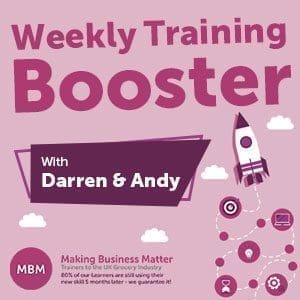Podcast: Play in new window | Download
Presenting to Make an Impact
Join Darren Smith in this webinar where he discusses 10 top tips using the mnemonic ‘presenting’ on how to make a presentation that has an impact.
Find out more about how you can change the way Learners deliver impactful presentations, whether they are internal or external. Also, help learners develop their knowledge and understanding of how to convey key messages, fully engage an audience, and deliver maximum influence.
Significantly increase your impact and influence when presenting with our Presentation Skills Training Course.
10 Top Tips


Procrastination
Have you ever put a job, a task, anything off until the last minute? Maybe you are too busy because the presentation is going to take so much time and effort that you just can’t find the time to do it this week.
STOP! Many people put presentations off because of what we like to call ‘the tinkering effect’. This is because, if you start a presentation early, you will keep changing it, adding new images, better content, and changing the font. DON’T DO THIS! Create the presentation until it is ‘Good Enough’. Don’t overspend time on it.

Rewarding Stories
You can show content in a table or a graph but this can be seen as offputting, boring. If you were to talk about a rewarding story, the chances are, that these will be remembered because no one wants to sit and read graphs and tables. After all, research shows that rewarding stories are remembered 22 times more because we can all relate to a story.
Think of a time when someone has told a story while presenting. You remember it, right? Now that same presentation, what graphs and tables did they show? Not so easy. This is presenting with impact. Tell rewarding stories. It doesn’t need to be a 20-minute story, just let it flow.

End in Mind
Stephen R. Covey, author of First Things First once said, “everything is created twice”, once in the mind and then in reality. The aim is to create an end in mind within your presentation. He called this Future Thinking meaning what do you want to see, feel and hear when presenting.
Mohammed Ali, when he was training, saw Joe Frazier on the Canvas. He said in an interview that Joe Frazier would go down in round 5 with a left hook and Joe Frazier heard. This embedded in Joe Frazier’s mind and he went down in round 5. The moral of the story, share your end in mind with your audience at the start of your presentation. This will help with presenting with impact.

Sir Aristotle
Sir Aristotle had a technique for presenting. Tell them what you’re going to tell them, tell them then tell them what you have told them. Also known as the Army Technique.
When presenting, tell your audience what you are going to be doing. During the presentation, you will tell them the content and at the end tell the audience what you have just told them. Start by explaining your objective, then deliver your objective and finally remind them of the objective. Embed the objective in their minds. Use the Army Technique.

Engaging Headlines
You head to a presentation. You see 4 headlines. 1. Total UK Population. 2. Total UK Population 1962 – 2022. 3. Total UK Population Growth Over 60 Years. 4. Better Health Care Doubles UK Population in 60 Years. Which one grabs your attention? It’s number 4 right?.
You read a newspaper and the thing that drawers your attention is the headline. Why? Because they are not ‘boring’ and they give an insight. Don’t just label your presentation because every part of your presentation has to earn its place. Use engaging headlines.

Nerves
Nerves will always show up when you don’t want them to. You’re about to do a presentation, you have prepared for this, you know your content, you know your stuff. You’re ready to start presenting with impact. You step out in front of your audience and bam, nerves hit you. What do you do? You have high energy, you want to calm down but you can’t because you can’t go from a high state of energy to calm in seconds.
Use this technique. You may dismiss this like many others before you but it works. Tell yourself, I am excited! This works because you can stay in a high energy state but just move from a negative to a positive high energy state. This has been researched by Molly Trainor.

Targets
We have our end in mind, what we hear, see and feel. End in mind is the ‘right brain stuff‘. This is the left brain stuff. Set yourself a SMART target.
Setting a SMART target will clarify your ideas, focus your efforts, use your time and resources productively, and increase your chances of achieving what you want out of your presentation. This will help to understand the point of the presentation and dictate the content you deliver to your audience when presenting.

Individual
We are all individuals and we all have a preferred thinking style. You may have heard of a HBDI Profile or Myer Briggs.
Take the HBDI profile. It is separated into four quadrants. Yellow and Red, the right side of the brain, and Blue and Green, the left side of the brain. Each individual will have a preferred learning style colour. Blue is fact-based, Green is Form, Yellow is Future and Red is Feel.
As a result, If we only present in our preferred learning style, we will only engage 25% of our audience because only 25% are in the same quadrant that you are. Write a checklist. Are we covering the four ”F’s? If you do, you will be presenting with impact.

No to Powerpoint
Did you know that 89% of people default to using slides and PowerPoint when presenting? It’s natural to do this because Microsoft has done a fantastic job of creating a programme that is easy and efficient to use.
As a result, we miss crucial aspects to making a presentation with impact, to make sure you are presenting with impact. We miss out on our end in mind and our targets. Use an alternative, a flipchart, a whiteboard, a mindmap. There are many alternatives. Start with your end in mind and targets because this will enable you to then choose which format is best to use.

Grabbing our Audience
The first few minutes and the last few minutes are crucial to grabbing your audience’s attention. If you start by thanking everyone for coming it’s not an attention grabber.
Start with facts. A quiz, a few questions, get your audience’s minds racing. If you can get them to start thinking and interacting at the start and at the end, your presentation has had an impact.





